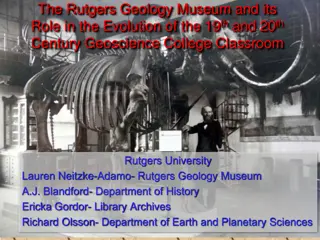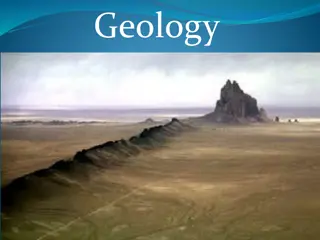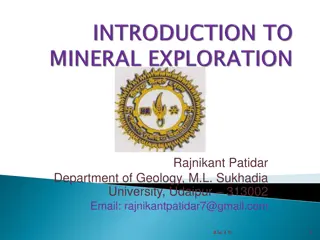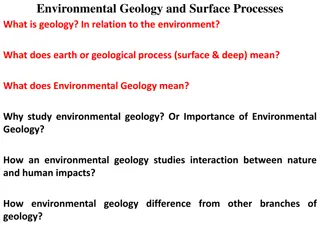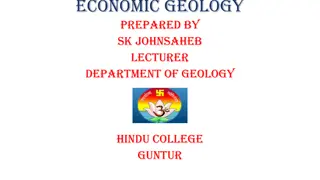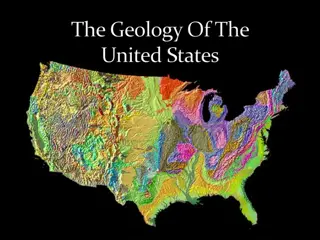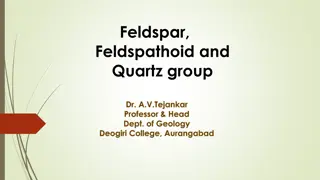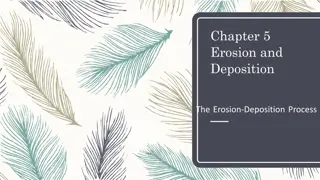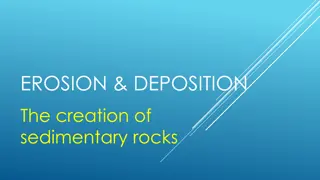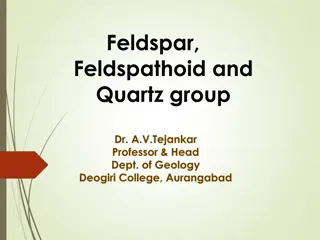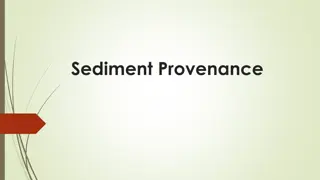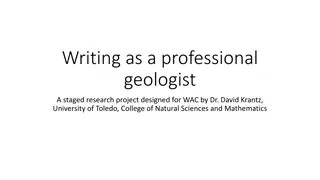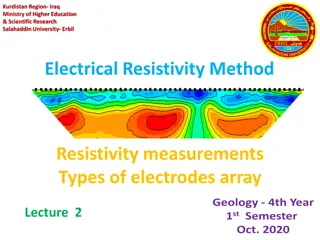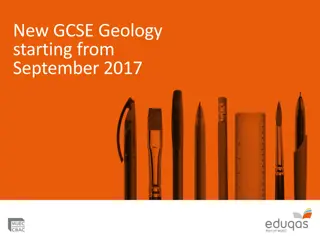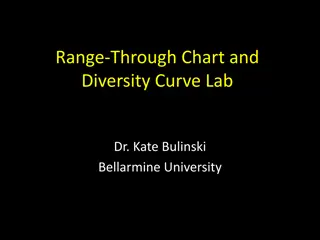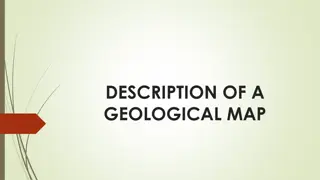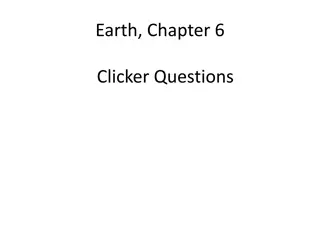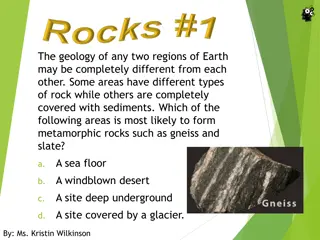Exploring Careers in Geology: Opportunities and Pathways
Geology is the scientific study of the Earth's physical structure, substances, history, and processes. This field offers diverse career opportunities, from teaching and economic geology to environmental and engineering geology. Geologists play crucial roles in understanding natural hazards, exploring mineral resources, and studying environmental impacts. With a mix of disciplines like biology, chemistry, and physics, geology attracts those passionate about earth sciences and exploration.
Download Presentation

Please find below an Image/Link to download the presentation.
The content on the website is provided AS IS for your information and personal use only. It may not be sold, licensed, or shared on other websites without obtaining consent from the author. Download presentation by click this link. If you encounter any issues during the download, it is possible that the publisher has removed the file from their server.
E N D
Presentation Transcript
PHYSICAL GEOLOGY WHAT IS GEOLOGY ? The science which deals with the physical structure and substance of the earth, their history, and the processes which act on them.
CARRER IN GEOLOGY. CARRER IN GEOLOGY. Do you have a passion for exploring the earth and materials? If yes, then Geology is one of the best career options for you. Since only the passion and interest in the job we are doing, helps us to grow and achieve our goals. Geology, in simple terms, is science related to earth and the substances it is made up of and how it has evolved with time. Geology is a mix of biology, chemistry, physics, and mathematics, which helps to evaluate the research and device results based on the data collected. Geology is an exciting career choice for those who like to work in fields, researching and studying about the landscapes, earthquakes, volcanoes, glaciers, water bodies, floods, groundwater flow, the mountains, mines, dinosaur evolution, and many more things which unfolds the nature of the earth.
Earth Science Teachers: teach 'earth science' (a mixture of geology, oceanography and climatology) in junior and senior high schools. A teaching certificate from a professional education program is also normally required. Economic Geologists: explore for and help produce metallic (iron, copper, gold, etc.) and non-metallic (coal, granite dimension stone, limestone aggregate sand and gravel, etc.) rock and mineral resources of economic value. Engineering Geologists: investigate the engineering properties of rock, sediment and soil below man-made structures such as roads, bridges, high-rise buildings, dams, airports, etc. Environmental Geologists: study the environmental affects of pollution on ground and surface waters and surficial materials (rock, sediment and soil), and also recommend solutions to environmental problems. They are also interested in understanding, predicting and mitigating the effects of natural hazards, such as flooding, erosion, landslides, volcanic eruptions, earthquakes, etc. Geochemists: investigate the chemical composition and properties of earth materials, especially polluted ground and surface waters, fossil fuels (such as petroleum and coal) and other resources of economic value.
Geology Professors: teach geology courses and conduct research in colleges and universities. Geomorphologists: study the origin and evolution of landscapes on the continental surfaces. Geophysicists: use the principles of physics to investigate the structure of the Earth's deep interior, explore for economic resources in the subsurface, and monitor pollution in ground water. Glacial or Quaternary Geologists: study the history of geologically recent (Quaternary period) glaciers as well as the sediment deposits and landforms they produced. Hydrogeologists: are concerned with water in the Earth's subsurface, including its sources, quality, abundance and movement. Hydrologists: are concerned with water on the Earth's surface, including its precipitation, evaporation and runoff, and its abundance and quality in streams and lakes. Marine Geologists: study the physical, chemical and biological characteristics of the sediments deposited on the ocean floors and the rocks that underlie them. Mineralogists: investigate the origins, properties and uses of the minerals occurring within the Earth's rocks. Paleontologists: study the remains of ancient animals and plants (fossils) in order to understand their behaviors, environmental circumstances, and evolutionary history.
Petroleum Geologists: explore for and help produce petroleum and natural gas from sedimentary rocks. Petrologists: study the origins and characteristics of igneous, metamorphic and sedimentary rocks. Sedimentologists: investigate the origins and characteristics of sediment deposits and the sedimentary rocks that form from them. Seismologists: are geophysicists who study earthquakes, both to better understand the physical processes involved and to interpret the deep internal structure of the Earth. Stratigraphers: investigate the time and space relationships among sedimentary and other rocks on local to global scales, and are also interested in the geochronology (absolute dating by radiometric methods) and fossil content of rock layers. Structural Geologists: study the folding, fracturing, faulting and other forms of deformation experienced by rocks below the Earth's surface, and are also interested in how these processes relate to global Plate Tectonics. Volcanologists: investigate volcanoes, especially their eruptions and deposits, in order to better understand physical processes involved and to predict volcanic eruptions.
STRUCTURE OF EARTH. INTERNAL STRUCTURE OF EARTH The shape of the earth is that of a spheroid with mean equatorial radius of 6378-388 km. The Earth can be divided by composition into the crust, mantle, and core, as shown to scale in the diagram to the right. The crust The crust consist mainly of igneous and metamorphic rocks with a relatively thin layer of sediment and sedimentary rocks on top. Crust comes in two varieties: continental and oceanic. Continental crust consists mainly of felsic rocks such as granite, and is about 30-50 km thick, varying from place to place; oceanic crust consists mainly of somewhat more mafic rocks such as basalt, and is about 5-10 km thick. The nature of these rocks suggests the reason why there is a crust as such To summarize the most important points, felsic rocks (i.e. those that have a high silica content) also have a lower density and a lower melting point than more mafic rocks.
THE CRUST. The crust of earth is mainly divided into 2 layers. 1.SiAl (UPPER CONTINENTAL CRUST) 2.SiMA (LOWER CONTINENTAL CRUST) Continental crust is mostly composed of different types of granites. Geologists often refer to the rocks of the continental crust as sial. Sial stands for silicate and aluminum, the most abundant minerals in continental crust. Sial can be much thicker than sima (as thick as 70 kilometers kilometers (44 miles)), but also slightly less dense (about 2.7 grams per cubic centimeter (1.6 ounces per cubic inch)). As with oceanic crust, continental crust is created by plate tectonics. At convergent plate boundaries, where tectonic plates crash into each other, continental crust is thrust up in the process of orogeny, or mountain-building. For this reason, the thickest parts of continental crust are at the world s tallest mountain ranges. Like icebergs, the tall peaks of the Himalayas and the Andes are only part of the region s continental crust the crust extends unevenly below the Earth as well as soaring into the atmosphere.
CONRAD DISCONTINUITY It seperates the si-al layer from the underlying sima layer.This discontinuity is a second order discontinuity and is located at a depth of 11km.
THE MANTLE. The mantle consists of a further 2890 kilometers of denser ultramafic rocks. It is sometimes wrongly stated that the mantle consists of molten rock. We know that this cannot be true because S-waves pass through the mantle, which would not be possible if it was a fluid. One reason for the popular belief in a liquid mantle is that, after all, lava, a liquid, erupts from out of the mantle. However, this lava is produced by partial melting of the solid mantle. This, incidentally, is why it has a different composition from the mantle, being more felsic. Although the mantle is not liquid, it does flow: technically, it is a ductile solid. It is the source region of most of the earth s internal energy and of forces responsible for oceanfloor spreading,continental drift,orogeny and major earthquakes.
DISCONTINUITIES INSIDE THE EARTH. Earth s interior is made of different kinds of materials. Each of those materials are different from each other by their physical and chemical properties, such as temperature, density etc. Unique layers are there according to their characteristics inside the earth. All those layers are separated from each other through a transition zone. These transition zones are called discontinuities. There are five discontinuies inside the earth. Conrad Discontinuity: Transition zone between SIAL and SIMA. Mohorovicic Discontinuity: Transition zone between the Crust and Mantle. Repiti Discontinuity: Transition zone between Outer mantle and Inner mantle. Gutenberg Discontinuity: Transition zone between Mantle and Core. Lehman Discontinuity: Transition zone between Outer core and Inner core.
THE CORE. It consists of three parts 1.Outer core. 2.Middle core. 3.Inner core. The core is the innermost part of the Earth, having a radius of 3,400 km. It can be divided into the outer core, which is molten, and the inner core, with a radius of 1,220 km, which is solid. (This arrangement may seem strange at first, but recall that the inner core is at greater pressure and so will have a higher melting point.) The core is made mainly of iron. As with the existence of the crust, this can be explained on the hypothesis of differentiation: just as the light substances rose to the top, so the denser substances would sink to the bottom.
Outer core. It extends from 2900 to 4982 kms.It is considered to be in a state of homogeneous fluid and it does not transmit S-waves. Studying the Core Geoscientists cannot study the core directly. All information about the core has come from sophisticated reading of seismic data, analysis of meteorites, lab experiments with temperature and pressure, and computer modeling. Most core research has been conducted by measuring seismic waves, the shock waves released by earthquakes at or near the surface. The velocity and frequency of seismic body waves changes with pressure, temperature, and rock composition.


